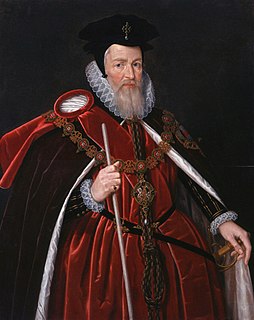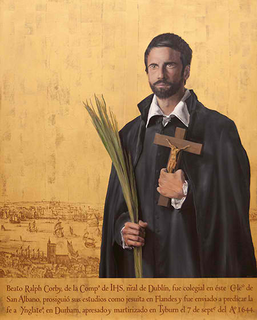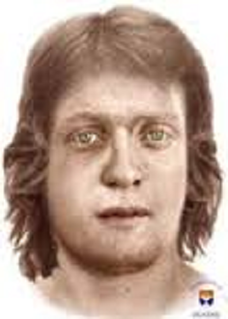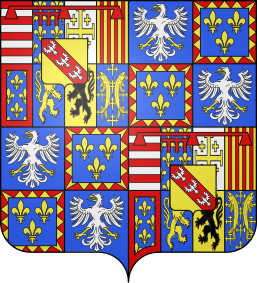Related Research Articles

Guy Fawkes, also known as Guido Fawkes while fighting for the Spanish, was a member of a group of provincial English Catholics who was involved in the failed Gunpowder Plot of 1605. He was born and educated in York; his father died when Fawkes was eight years old, after which his mother married a recusant Catholic.

Pope Leo XI, born Alessandro Ottaviano de' Medici, was head of the Catholic Church and ruler of the Papal States from 1 April 1605 to his death. His pontificate is one of the briefest in history, having lasted under a month. He was from the prominent House of Medici originating from Florence. Medici's mother opposed his entering the priesthood and sought to prevent it by having him given secular honours, but after her death he eventually was ordained a priest in 1567. In his career he served as Florence's ambassador to the pope, Bishop of Pistoia, Archbishop of Florence, papal legate to France, and as the cardinal Prefect for the Congregation of the Bishops and Religious. He was elected to the papacy in the March 1605 papal conclave and served as pope for 27 days.

William Cecil, 1st Baron Burghley was an English statesman, the chief adviser of Queen Elizabeth I for most of her reign, twice Secretary of State and Lord High Treasurer from 1572. In his description in the Encyclopædia Britannica Eleventh Edition, Albert Pollard wrote, "From 1558 for forty years the biography of Cecil is almost indistinguishable from that of Elizabeth and from the history of England."

The French Wars of Religion is the term used for a period of civil war from 1562 to 1598 between French Catholics and Protestants, commonly called Huguenots. Estimates suggest between two to four million people died from violence, famine or disease directly arising from the conflict, which also severely damaged the power of the French monarchy. Fighting ended in 1598 when the Protestant Henry of Navarre converted to Catholicism, was proclaimed Henry IV of France and issued the Edict of Nantes, granting the Huguenots substantial rights and freedoms. However, this did not end Catholic hostility towards Protestants in general or him personally, and his assassination in 1610 led to a fresh round of Huguenot rebellions in the 1620s.

William II de la Marck was the Dutch Lord of Lumey and initially admiral of the Watergeuzen, the so-called 'sea beggars' who fought in the Eighty Years' War (1568–1648), together with among others William the Silent, Prince of Orange-Nassau. He was the great-grandson of an equally notorious character, baron William de la Marck, nicknamed the "wild boar of the Ardennes".

John Jones, also known as John Buckley, John Griffith, Godfrey Maurice, or Griffith Jones was a Franciscan friar, Roman Catholic priest, and martyr. He was born at Clynnog Fawr, Caernarfonshire (Gwynedd), Wales, and was executed 12 July 1598 at Southwark, England. He is one of the Forty Martyrs of England and Wales.

John Rigby was an English Roman Catholic layman who was executed during the reign of Elizabeth I. He is one of the Forty Martyrs of England and Wales.

Britton "Brit" Chance was an American biochemist, biophysicist, scholar, and inventor whose work helped develop spectroscopy as a way to diagnose medical problems. He was "a world leader in transforming theoretical science into useful biomedical and clinical applications" and is considered "the founder of the biomedical photonics." He received the National Medal of Science in 1974.
Robert Nutter was an English Catholic priest, Dominican friar and martyr. He was beatified in 1987.

Ralph Corbie was an Irish Jesuit. He is a Catholic martyr, beatified in 1929.
Thurston Hunt was an English Roman Catholic priest. He was tried and executed with Robert Middleton, also a priest. They were declared to be martyrs by the Catholic Church, and beatified in 1987, by Pope John Paul II.

Peter Snow was an English Roman Catholic priest. He is a Catholic martyr, along with Ralph Grimston who died with him, beatified in 1987. Their liturgical celebration is on 15 June.

Thomas Tichborne was an English Roman Catholic priest. He is a Catholic martyr.
Nicholas Tichborne was an English Roman Catholic layman, a recusant and Catholic martyr. He is to be distinguished from the Nicholas Tichborne who died in Winchester Gaol in 1587 who was his father.
John Lockwood was an English Roman Catholic priest. He is a Catholic martyr, beatified in 1929.
Christopher Robinson was an English Catholic priest and martyr, beatified in 1987.

The Battle of Craon took place between 21–24 May 1592, between the French Royal army under the Duke of Montpensier and François de Bourbon, Prince of Conti, reinforced by English contingents under Sir John Norreys, against the combined forces of Spain and the Catholic League of France during the War of the Three Henrys and the Anglo-Spanish War (1585–1604), in the context of the French Wars of Religion. Craon was besieged by the army of Henry of Navarre, but the defenders, supported by a Catholic relief force recruited by Philippe Emmanuel, Duke of Mercœur, resisted. At the end, Craon was relieved by the Spaniards under Don Juan del Águila, who defeated the Anglo-French besiegers.

The Sixto-Clementine Vulgate or Clementine Vulgate is the edition promulgated in 1592 by Pope Clement VIII of the Vulgate—a 4th-century Latin translation of the Bible that was written largely by Jerome. It was the second edition of the Vulgate to be authorised by the Catholic Church, the first being the Sixtine Vulgate. The Sixto-Clementine Vulgate was used officially in the Catholic Church until 1979, when the Nova Vulgata was promulgated by Pope John Paul II.
Simon Robson was Dean of Bristol from 1598 to 1617.